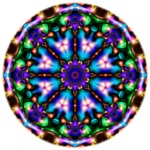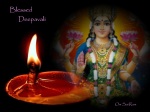Diwali 2009 – Festival Of Lights – Deepavali 2009
2009: Deepavali / Diwali Will Be Celebrated On October 17th 2009
Diwali 2009 – Divali – Dewali – Devali – Deepavali 2009 – Depavali – Deepawali – Festival Of Lights – Celebration Of Light – Dipavali – Diwali Wallpapers – Hari Deepavali – Row Of Lights – Dipawali – Lakshmi Puja – Laxsmi Pooja – Naraka Chaturdashi – Balipadyami – Dhanatravodashi – Narakchaturdashi – Kali Puja
Diwali, or Deepavali, (also called Tihar and Swanti in Nepal) is a major Indian and Nepalese festival, and a significant festival in Hinduism, Sikhism and Jainism. Many legends are associated with Diwali. Today it is celebrated by Hindus, Jains and Sikhs across the globe as the “Festival of Light” or “Celebration of Light” where the lights or lamps signify victory of good over evil within every human being. The festival is also celebrated by Buddhists of Nepal, particularly the Newar Buddhists.
According to one theory Diwali may have originated as a harvest festival, marking the last harvest of the year before winter. In an agrarian society this results in businessmen closing accounts, and beginning a new accounting year. The Goddess Lakshmi (the Goddess of wealth in Hinduism) thanked and worshipped on this day and everyone prays for a good and prosperous year ahead. This is the common factor in Diwali celebrations all over the Indian subcontinent.
In many parts of India, it is the homecoming of King Rama of Ayodhya after a 14-year exile in the forest. The people of Ayodhya (the capital of his kingdom) welcomed Rama by lighting rows (avali) of lamps (deepa), thus its name, Deepawali / Deepavali, or simply shortened as Diwali. South India marks this day when Lord Krishna defeated the demon Narakasura. In western India it is also in honor of the day King Bali went to rule the nether-world by the order of Vishnu. (There is another festival ‘Onam’ which is celebrated in Kerala around the month of August to mark this legend).
Diwali is celebrated on the first day of the lunar Kartika month, which comes in the month of October or November.
In Jainism it marks the nirvana of Lord Mahavira, which occurred on October 15, 527 BCE. The Sikhs celebrate Diwali for a different reason. On this day, the Sixth Guru, Guru Hargobind Ji, was freed from imprisonment along with 52 Hindu Kings (political prisoners) whom he had arranged to be released as well. After his release he went to Darbar Sahib (golden temple) in the holy city of Amritsar. There, he was greeted by Sikhs and many other people. In happiness they lit candles and diyas to greet the Guru. In India, Diwali is now considered to be a national festival, and the aesthetic aspect of the festival is enjoyed by most Indians regardless of faith.
The festival marks the victory of good over evil, and uplifting of spiritual darkness. Symbolically it marks the homecoming of goodwill and faith after an absence, as suggested by the Ramayana.
On the day of Diwali, many wear new clothes and share sweets and snacks. Some North Indian business communities start their financial year on Diwali and new account books are opened on this day.
Hindus have several significant events associated with it:
- Return of Lord Rama to Ayodhya: Diwali also celebrates the return of Lord Rama, King of Ayodhya, with his wife Sita and brother Lakshmana to Ayodhya after a 14 year exile, and a war in which he killed the demon king Ravana. It is believed that the people of Ayodhya lit oil lamps along the way to light their path in the darkness. Since Lord Rama traveled from South India to his kingdom in North India, he passed through the south earlier. This is the reason why the festival is celebrated a day earlier in South India.
- The Killing of Narakasura: Celebrated as Naraka Chaturdasi, two days before Diwali day, it commemorates the killing of Narakasura, an evil demon who created havoc, by Lord Krishna’s wife Satyabhama. This happened in the Dwapar Yuga during this time of Lord Krishna’s avatar. In another version, the demon was killed by Lord Krishna (Lord krishna provokes his wife Satyabhama to kill Narakasura by pretending to be injured by the demon. Narakasura can only be killed by his mother, Satyabhama) himself. Before Narakasura’s death, he requested a boon from his mother, Satyabhama (believed to be an Avatar of Bhudevi – Narakasura’ mother), that everyone should celebrate his death with colorful light.
- Austerities of Shakti: According to the Skanda Purana, the goddess Shakti observed 21 days of austerity starting from ashtami of shukla paksha (eighth day of the waxing period of moon) to get half of the body of Lord Shiva. This vrata (austerity) is known as kedhara vrata. Deepavali is the completion day of this austerity. This is the day Lord Shiva accepted Shakti into the left half of the form and appeared as Ardhanarishvara. The ardent devotees observe this 21 days vrata by making a kalasha with 21 threads on it and 21 types of offerings for 35 days. The final day is celebrated as kedhara gauri vrata.
- Krishna defeating Indra: Govardhan Puja is celebrated the day after Diwali. It is the day Lord Krishna defeated Indra, the deity of thunder and rain. As per the story, Krishna saw huge preparations for the annual offering to Lord Indra and questions his father Nanda about it. He debated with the villagers about what their ‘dharma’ truly was. They were farmers, they should do their duty and concentrate on farming and protection of their cattle. He continued to say that all human beings should merely do their ‘karma’, to the best of their ability and not pray for natural phenomenon. The villagers were convinced by Krishna, and did not proceed with the special puja (prayer). Indra was then angered, and flooded the village. Krishna then lifted Mt Govardhan and held it up as protection to his people and cattle from the rain. Indra finally accepted defeat and recognized Krishna as supreme. This aspect of Krishna’s life is mostly glossed over – but it actually set up the basis of the ‘karma’ philosophy later detailed in the Bhagavat Gita.
- Bali’s return to the nether world: In Bhavishyottara and Brahma Vaivarta Purana, Diwali is associated with the Daitya king Bali, who is allowed to return to earth once a year. However in Kerala this is the reason ‘Onam’ is celebrated. ‘Onam’ festival falls around the month of August-September.
Sathya Sai Baba: Deepavali means “the array of lights.” “Thamasomaa jyotirgamaya” (Lead me from darkness to light) is an Upanishadic prayer: This means that where there is darkness light is needed. What is this darkness? Sorrow, restlessness, loss, disappointment, misery and lack of enthusiasm are all different forms of darkness. To get rid of the darkness of sorrow, you have to light the lamp of happiness. To dispel the darkness of disease, you have to install the light of health. To get over the darkness of losses and failures, you have to usher in the light of prosperity.
Looking at the Deepavali festival from the scientific point of view, it should be noted that at one time in the distant past, our ancestors lived in the Arctic region (the polar region). In this region, darkness prevailed for six months. The sun appears on Mesha Sankranthi day (the sun entering the Aries sign of the Zodiac). The sun sets in this region on Tula Sankranthi day (when the sun enters Libra). In the movement between these two signs, there is an interval of six months. After the sun sets in Libra, the dark half-year starts.
Today is Chathurdasi (the fourteenth day) in the month of Karthik. It is Amavasya (New Moon day). The month is called Kaumudi. The people in the polar region used to start lighting their lamps from this day. The lighting of the lamp is not without other significance. As they would be in darkness for a long period, they described the lamp that was lit as Nithyajyothi (the perennial light).
It was on Deepavali day that Sri Rama’s coronation took place after his victorious return to Ayodhya from Lanka vanquishing Ravana and his Rakshasa brood. For a long period Ayodhya had been plunged in darkness when Rama was in exile in the forest. In the absence of the effulgent Rama, Ayodhya was a city of darkness. The forests were filled with light. The return of Rama was hailed by the people of Ayodhya as the return of divine effulgence and hence they celebrated the event by the lighting of lamps everywhere.
Nor is that all. Today’s festival is marked by other significant features. This is the day on which the Lord in His Vamana incarnation sent the Emperor Bali to the Nether World after He got the promise of three feet of ground (measured by the Lord’s foot) from Bali. Vamana (as the incarnation of Vishnu) used the gift of three feet of land to put down the Ahamkara (egoism) of Bali.
Deepavali is a festival which is designed to celebrate the suppression of the Ego by the Higher Self. Man is plunged in the darkness of ignorance and has lost the power of discrimination between the permanent and the evanescent. When the darkness of ignorance caused by Ahamkara (the ego-feeling) is dispelled by the light of Divine knowledge, the effulgence of the Divine is experienced. Deepavali is also the day on which Emperor Vikrama ditya ascended the throne.
If the darkness of ignorance is to be dispelled, man needs a container, oil, wick and a matchbox corresponding to what an external lamp needs. For man, the heart is the container. The mind is the wick. Love is the oil and vairagya (sacrifice) is the matchbox. When you have these four, Atma-jyothi (the Divine flame of the Spirit) shines effulgently. When the light of the Spirit is aflame, the Light of Knowledge appears and dispels the darkness of ignorance.
The flame of a lamp has two qualities. One is to banish darkness. The other is a continuous upward movement. Even when a lamp is kept in a pit, the flame moves upwards. The sages have therefore adored the lamp of wisdom as the flame that leads men to higher states. Hence, the effulgence of light should not be treated as a trivial phenomenon. Along with lighting the external lamps, men should strive to light the lamps within them. The human estate should be governed by sacred qualities. This calls for the triple purity of body, mind and speech–Trikarana Suddhi (purity of the three instruments).
The inner significance of Deepavali is to lead man from darkness to light. Man is perpetually plunged in darkness. Every time he is enveloped in darkness, he should light a lamp that is ever shining within him. Carry that lamp wherever you go. It will light your path wherever you may be. (Sathya Sai Baba – Diwali Discourse 1991)
Diwali 2009 – Divali – Dewali – Devali – Deepavali 2009 – Depavali – Deepawali – Festival Of Lights – Celebration Of Light – Dipavali – Diwali Wallpapers – Hari Deepavali – Row Of Lights – Dipawali – Lakshmi Puja – Laxsmi Pooja – Naraka Chaturdashi – Balipadyami – Dhanatravodashi – Narakchaturdashi – Kali Puja
For More Diwali Greetings and Deepavali Wallpapers, See:
– 01 – 02 – 03 – 04 – 05 – 06 – 07 – 08
Filed under: Celebration Of Light, Festival Of Lights, Kali Puja, Lakshmi Puja, Laskhmi Pooja, Laxsmi Pooja, Naraka Chaturdashi, Row Of Lights, Sai Baba, sathya sai baba | Tagged: Balipadyami, Deepavali, Deepawali, Depavali, Depawali, Devali, Dewali, Dhanatravodashi, Dipavali, Dipawali, Divali, Diwali, Lakshmi, Narakchaturdashi | 2 Comments »














You must be logged in to post a comment.